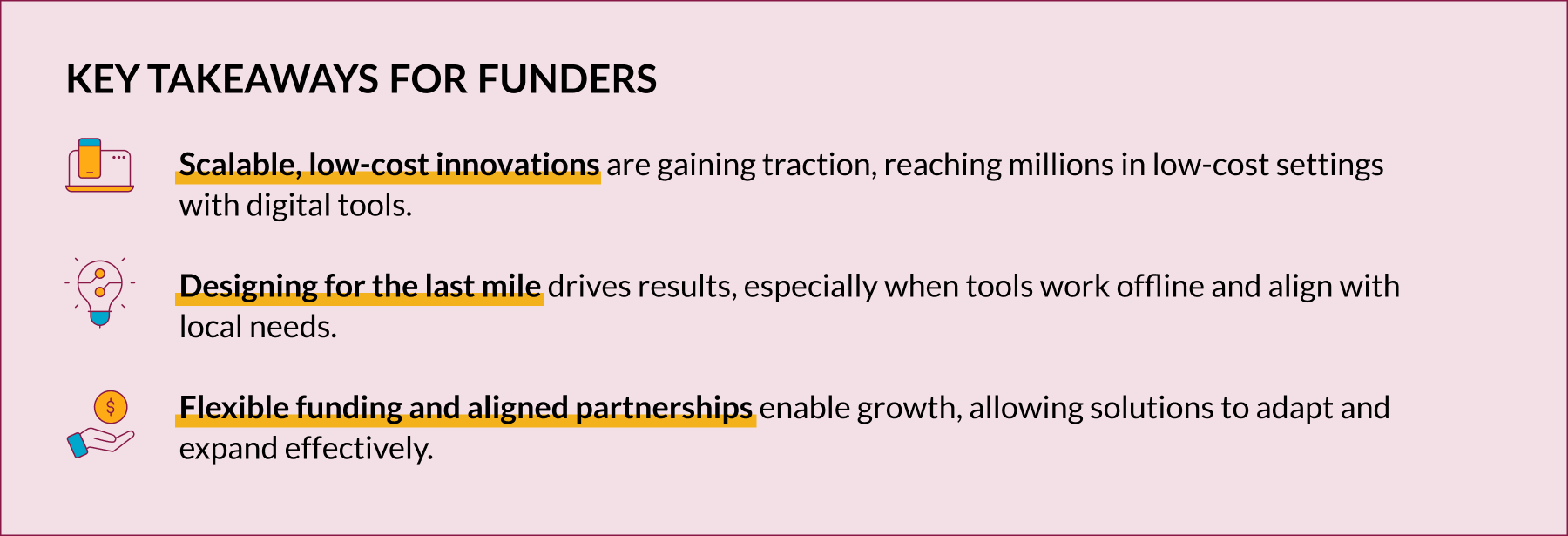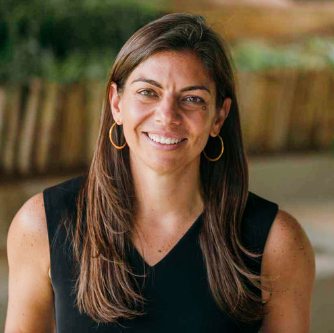Dalberg uses cookies and related technologies to improve the way the site functions. A cookie is a text file that is stored on your device. We use these text files for functionality such as to analyze our traffic or to personalize content. You can easily control how we use cookies on your device by adjusting the settings below, and you may also change those settings at any time by visiting our privacy policy page.
This year, the World Health Organization’s World Health Day theme is “Healthy Beginnings, Hopeful Futures,” spotlighting the urgency of improving maternal and newborn health. Maternal and newborn health is a foundational driver of societal well-being. Over the past two decades, the world has made significant progress: between 2000 and 2023, global maternal mortality declined by 40%—from 328 to 197 deaths per 100,000 live births—and neonatal mortality fell by 44% (UNICEF 2025a; WHO 2024a). Yet these gains are uneven and insufficient. Every day, around 800 women and 6,300 newborns die from preventable causes (Khalil et al. 2023; UNICEF 2025b). Nearly 95% of maternal deaths occur in low- and middle-income countries (WHO 2024b), and 57% of under-five child deaths take place in Sub-Saharan Africa (WHO 2024a)—revealing a stark equity gap that demands urgent action.
Digital and AI-enabled innovations offer a powerful opportunity to bridge these long-standing gaps by expanding access, improving quality of care, and enabling faster, more informed decision-making. From decision-support tools and wearable tech to community-based platforms and personalized chatbots, these solutions are already transforming how and where care is delivered. When rooted in community insight and designed with users in mind, they become more relevant, trusted, and impactful.
We work across global health ecosystems to uncover scalable solutions that improve care. The insights below reflect lessons from our work advising the private sector, multilateral organizations, philanthropic institutions, and NGOs around the world. The five innovations featured highlight what’s possible when technology meets local context—and when funders commit to models designed for both scale and equity.
AskNivi: AI-Powered Reproductive Health Access and Education
Women and girls in many low- and middle-income countries face persistent barriers to accurate, timely, and confidential reproductive health information. In response, Nivi, Inc. launched AskNivi, an AI-powered chatbot that offers personalized guidance on topics such as contraception, family planning, and sexual health. Piloted in Kenya in 2015 and launched in 2016, the platform is accessible via WhatsApp and SMS, and currently operates in Kenya, India, and Nigeria. Its AI engine continuously adapts to users’ literacy levels, locations, and behaviors—enabling real-time personalization that reflects both user input and local context. Supported by MSD for Mothers, Population Council, and other global partners, AskNivi connects users to curated content, local providers, and a feedback loop that helps improve service quality.
AskNivi has reached 1.95 million users and facilitated over 9.1 million health-related conversations across Kenya, India, and Nigeria. By meeting users where they are—with technology they trust—the platform enables discreet, user-driven engagement and connects them to providers offering a full range of contraceptive options. It also gathers feedback on care experiences, strengthening both access and accountability in reproductive health. Its behaviorally informed, scalable model offers a promising solution for advancing equity in low-resource settings.
ASMAN Platform: Enhancing Intrapartum and Postpartum Care through Digital Solutions
Inconsistent clinical practices during labor and delivery contribute to preventable maternal and newborn complications. In response, the Alliance for Saving Mothers and Newborns (ASMAN) launched in India in 2017. ASMAN software equips frontline providers with digital partographs, clinical decision support, and real-time monitoring tools.
Deployed across 81 public health facilities in Rajasthan and Madhya Pradesh, ASMAN has supported over 266,000 deliveries and significantly improved adherence to clinical protocols. It has led to a 91% increase in partograph use, 97% adherence to active management of the third stage of labor (AMTSL), and a 33% rise in eclampsia case management. The platform has also reduced delays in life-saving care by improving complication identification and lowering unnecessary referrals. ASMAN’s scalable model offers a proven approach to reducing maternal and neonatal mortality and improving quality of care in low-resource settings.
DawaMom: AI-Powered Maternal Care at the Last Mile
Expectant mothers in rural areas need timely health guidance, risk monitoring, and access to basic antenatal diagnostics. Founded in 2019 in Zambia, Dawa Health developed DawaMom to address this need. The AI-powered platform delivers weekly, personalized health advice via a chatbot in multiple languages—including Lozi, Nyanja, Bemba, English, and sign language—and is accessible through an app, SMS, web portal, and WhatsApp. Its design was informed by surveys with rural mothers, which revealed barriers such as limited smartphone access—leading to the addition of a USSD-SMS version tailored to their needs. It also supports community health workers with refresher training and on-demand information, equipping them to deliver more timely and informed care.
DawaMom has supported over 5,000 mothers and facilitated more than 10,000 chat interactions. Notably, 84% of women who received DawaMom’s hemoglobin tests had never undergone antenatal blood screening before—underscoring the platform’s role in closing critical diagnostic gaps. By combining AI-driven insights with last-mile service delivery, DawaMom is helping to improve pregnancy outcomes in low-resource settings. The platform has received recognition from the Clinton Health Access Initiative and the UNDP, and its low-cost, scalable model holds promise for broader adoption.
MomConnect: Transforming Maternal Health Through Mobile Technology
In South Africa, many pregnant women—particularly in underserved areas—require timely and culturally relevant maternal health information. To address this, the National Department of Health launched MomConnect in 2014 to provide consistent support throughout pregnancy and early childhood. Developed with partners including Johnson & Johnson, USAID, WHO, and UNICEF, the platform delivers free, stage-based messages via SMS and WhatsApp—from early pregnancy until a child’s second birthday. It includes a helpdesk—available in all 11 official South African languages—that enables two-way communication, allowing mothers to ask questions, share feedback, and inform service improvements.
MomConnect has reached nearly 5 million users, with 95% of South Africa’s public health facilities supporting enrollment during routine antenatal visits. It has contributed to increased antenatal care attendance, improved patient engagement, and stronger accountability in public services. As one of the first government-led mHealth programs to reach national scale, MomConnect offers a proven, low-cost model for expanding maternal health education and engagement—demonstrating how mobile technology can strengthen health systems in resource-limited settings.
Khushi Baby: Bridging the Gap in Child Immunization through Wearable Technology
In rural India, fragmented health records and limited digital infrastructure often disrupt the continuity of maternal and child healthcare. Founded in 2014, Khushi Baby addresses this gap through a low-cost, wearable health record system. A necklace embedded with an NFC chip stores each child’s vaccination and medical history, which community health workers can access and update using a mobile app—even in areas without internet access. Co-created with community health workers and families through over 200,000 hours of field engagement, the platform integrates mobile health, cloud computing, and real-time analytics to support data collection and monitoring tailored to local workflows and offline settings.
Over the past decade, Khushi Baby has equipped 75,000 community health workers—reaching over 48 million people—with support from Gavi, WHO, UNFPA, Google AI, and PATH. In Rajasthan alone, it has tracked around 200,000 mothers and children and increased full immunization coverage by 66%. At just 300 Indian Rupees (~USD 4) per unit, Khushi Baby offers a scalable, cost-effective solution for digitizing last-mile health systems and extending care to underserved populations.
Looking Ahead

From our experience supporting and analyzing maternal and newborn health innovations, several design principles stand out. Successful solutions are built for last-mile delivery, shaped by community insights, and embedded into existing health systems—balancing global scalability with local adaptability. They work not in isolation but through integration with health workers, infrastructure, and referral networks, tailored to local languages, norms, and care pathways.
Digital innovation is a strong lever for progress. To move from small-scale pilots to sustainable, system-wide change, we must invest in solutions designed for local communities and health systems—responsive to the needs of women and providers alike. Progress is rooted in collaboration across governments, funders, innovators, and communities. With the right focus and follow-through, we can turn promising tools into lasting impact for mothers and newborns.
For further details, please contact:



